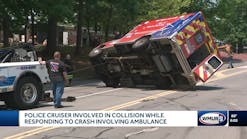WASHINGTON (AP) -- Pentagon Police Sgt. Hammie Ashton Jr. remembers the sound of the plane crashing into the building. Amid the devastation, he remembers being grateful the subway kept running to help people evacuate the area.
''It was very critical that day because people couldn't gain access to their vehicles,'' Ashton said, recalling how some parking lots and other areas were blocked off.
Because of this experience, Ashton said he was already on-board with the idea that people and vehicle traffic flow must be a consideration during an emergency. To that end, Metro now offers training classes for first responders, to help them understand how to balance the safety needs of victims and emergency workers, with the need to keep traffic moving. They also learn practical skills, like how to evacuate trains and how to test if the electrified third rail is on, and if so, how to turn it off.
Top brass from area fire and police departments attended one of the first classes along with federal officials from the State Department, Pentagon and Capitol Police.
They looked at photos from accident scenes with trainer Michael Kelly, a battalion chief from a Chicago-area fire department, pointing out ways to better manage the scene. In one photo, a fire truck parked diagonally, blocking one full lane and part of the next.
''If you need the lane, take the lane, don't take half the lane,'' Kelly said. He pointed out that 38 percent of traffic accidents are secondary, resulting from traffic jams or other situations caused by the first accident.
Then they broke into groups to test out what they learned. In one drill they considered what to do if a subway train derailed along Interstate-66, where the Orange Line tracks separate the east and westbound lanes.
Arlington County Fire Battalion Chief Jim Daugherty said they learned about options to keep the Metro running, like single tracking trains at slow speeds around first responders.
District of Columbia Deputy Fire Chief John Thumann said some of the information on how to deal with the traffic problem was new for him.
Daugherty and Thumann agreed one of the most valuable aspects of the training program was the chance to spend the day with police and fire officials from other jurisdictions, people they will likely meet again one day at an emergency scene.
The training program is the result of a grant from the Homeland Security Department and a response to lessons learned.
Metro Transit Police Capt. Jeff Delinski said during the Woodley Park train collision last November, emergency workers had trouble getting to scene because of traffic backups.
D.C. Police Lt. Jesse Porter said he wished he had this training earlier this spring when he was called to the Minnesota Avenue station for reports of a train derailment. Porter said it turned out to be just a simple mechanical fire, but he arrived to a scene with police parked in one area and the fire trucks in another, and traffic having trouble getting around.





